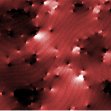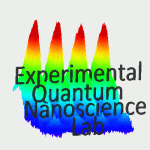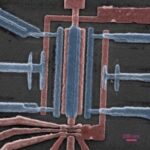
 The Semiconductor Spectroscopy and Devices research group is part of the Nanoscience division of the Department of Physics at the University of Strathclyde. The Department is a member of the Scottish Universities Physics Alliance (SUPA).
The Semiconductor Spectroscopy and Devices research group is part of the Nanoscience division of the Department of Physics at the University of Strathclyde. The Department is a member of the Scottish Universities Physics Alliance (SUPA).
Research interests
💎 Semiconductor materials and device issues:

- Group III nitrides: AlN, GaN, InN and their alloys
- Materials doped with rare earth ions such as Eu3+
- Chalcopyrites and kesterites for solar cells, such as Cu(In,Ga)(S,Se)2 and CZTS
- Gallium oxide optoelectronic devices
🎇 Spatially and spectrally resolved luminescence:

- Low-temperature photoluminescence spectroscopy
- Cathodoluminescence spectroscopy and hyperspectral imaging
- Electroluminescence hyperspectral imaging
🔬 Advanced scanning electron microscopy techniques:

- Electron backscatter diffraction
- Electron channelling contrast imaging
- Electron beam induced current
- Wavelength and energy-dispersive X-ray spectroscopy
⚛️ Experimental quantum nanoscience:

- Physics and applications of polariton condensates in microcavities
- Solid-state quantum systems for quantum information and nanophotonics
- Hybrid polariton-quantum dot platforms for scalable quantum hardware
🧮️ Semiconductor quantum electronics (SEQUEL):

- Semiconductor nanoscale systems
- Quantum computing and quantum electrical metrology
- Electrical initialisation and readout of spin qubits in SiC
- Empowering Practical Interfacing of Quantum Computing (EPIQC)
📰 Group news
- October 2025: Well done to Stefan Nicholson, who has successfully defended his PhD thesis. His work on perovskite solar cells was undertaken jointly between SSD and the group of Dr Aruna Ivaturi in the Department of Pure and Applied Chemistry.
- March 2025: Congratulations to Dr Fabien Massabuau who has won the Materials Young Investigator Award.
- October 2024: Welcome to Farnaz Hadizadeh who joins the GOOD group as a PhD student with Diamond Jubilee Research Scholarship.
- August 2024: Welcome to Mohammed Alessa who joins the GOOD group as a PhD student.
- June 2024: Welcome to Adam McMorris who won a Carnegie Vacation Scholarship for conducting a summer project in the GOOD group.
- April 2024: Welcome to Sean Douglas who joins the group as a post-doc working on project “Tuneable radiation-resilient (AlGa)2O3 UVC photodetectors” funded by the UK Space Agency.
🥼 Join us! Jobs / PhD studentships available
- Funded PhD studentships in UV-C semiconductor characterisation and experimental quantum nanoscience.
📖 Latest publications
-
![[doi]](https://ssd.phys.strath.ac.uk/wp-content/plugins/papercite/img/external.png) Electronic, magneto-optical and magneto-transport properties of the topological insulator Sb2Te2Se
Electronic, magneto-optical and magneto-transport properties of the topological insulator Sb2Te2Se -
![[doi]](https://ssd.phys.strath.ac.uk/wp-content/plugins/papercite/img/external.png) Optical pumping and initialization of a hole spin in site-controlled InGaAs pyramidal quantum dots
Optical pumping and initialization of a hole spin in site-controlled InGaAs pyramidal quantum dots -
![[doi]](https://ssd.phys.strath.ac.uk/wp-content/plugins/papercite/img/external.png) Molecular beam epitaxy of boron arsenide layers
Molecular beam epitaxy of boron arsenide layers -
![[doi]](https://ssd.phys.strath.ac.uk/wp-content/plugins/papercite/img/external.png) Strain-induced modifications of thin film silicon membranes by physical bending
Strain-induced modifications of thin film silicon membranes by physical bending -
![[doi]](https://ssd.phys.strath.ac.uk/wp-content/plugins/papercite/img/external.png) Hyperspectral alignment capability for direct writing systems enabled by structured illumination with a micro-LED array
Hyperspectral alignment capability for direct writing systems enabled by structured illumination with a micro-LED array -
![[doi]](https://ssd.phys.strath.ac.uk/wp-content/plugins/papercite/img/external.png) Role of the electron transport layer in dictating the nanoscale heterogeneity in all-inorganic perovskite absorbers – correlating the optoelectronic and crystallographic properties
Role of the electron transport layer in dictating the nanoscale heterogeneity in all-inorganic perovskite absorbers – correlating the optoelectronic and crystallographic properties -
![[doi]](https://ssd.phys.strath.ac.uk/wp-content/plugins/papercite/img/external.png) Strain and luminescence properties of hexagonal hillocks in N-polar GaN
Strain and luminescence properties of hexagonal hillocks in N-polar GaN -
![[doi]](https://ssd.phys.strath.ac.uk/wp-content/plugins/papercite/img/external.png) Investigation of (mis-)orientation in zincblende GaN grown on micro-patterned Si(001) using electron backscatter diffraction
Investigation of (mis-)orientation in zincblende GaN grown on micro-patterned Si(001) using electron backscatter diffraction
📣 LinkedIn posts

